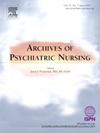Cyberbullying, psychosocial problems and affecting factors among adolescents
IF 2.2
4区 医学
Q1 NURSING
引用次数: 0
Abstract
Purpose
The aim of the study is to examine cyberbullying, psychosocial problems and the factors affecting them among adolescents.
Design and methods
A cross-sectional study was conducted in Türkiye. The population of the study consisted of 5th, 6th, 7th, and 8th-grade students from a public middle school. Data were collected through a descriptive characteristics questionnaire, Cyberbullying Scale, and Pediatric Symptom Checklist.
Results
Both psychosocial problems and cyberbullying levels were found to be significantly higher in students who were male, in the 7th and 8th grades, and who used the internet for 3 h or more per day (p < .05). It was found that the level of psychosocial problems was significantly higher in students who had chronic diseases, who used medication regularly, and whose parents had a high school education or lower (p < .05). A weak positive correlation was found between the Pediatric Symptom Checklist and Cyberbullying Scale (r = 0.169, p < .001). Daily internet usage time and cyberbullying explained 7.6 % of psychosocial problems.
Conclusions
The study found that adolescents' psychosocial problems were associated with the level of cyberbullying, and that gender, grade level, and daily internet use duration affected psychosocial problems and cyberbullying, while the presence of a chronic disease and the level of parental education affected psychosocial problems. Daily internet usage time and cyberbullying were predictors of psychosocial problems. It is recommended that educational programs on safe internet use be provided, especially for male adolescents in grades 7–8 who spend more than 3 h a day on the internet.
求助全文
约1分钟内获得全文
求助全文
来源期刊
CiteScore
3.70
自引率
0.00%
发文量
131
审稿时长
160 days
期刊介绍:
Archives of Psychiatric Nursing disseminates original, peer-reviewed research that is of interest to psychiatric and mental health care nurses. The field is considered in its broadest perspective, including theory, practice and research applications related to all ages, special populations, settings, and interdisciplinary collaborations in both the public and private sectors. Through critical study, expositions, and review of practice, Archives of Psychiatric Nursing is a medium for clinical scholarship to provide theoretical linkages among diverse areas of practice.

 求助内容:
求助内容: 应助结果提醒方式:
应助结果提醒方式:


